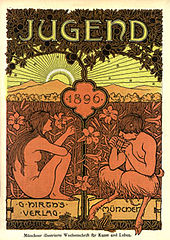Maison de l'Art Nouveau (House of New Art) was the name of the gallery opened in 1895 by the German art dealer Samuel Bing in Paris that marked his exclusive focus on modern art.[16][17] The fame of his gallery was increased at the 1900 Exposition Universelle, where he presented coordinated—in design and color—installations of modern furniture, tapestries and objets d'art.[17] These fully realised decorative displays became so strongly associated with the style that the name of his gallery subsequently provided a commonly used term for the entire style: Art Nouveau.[17]

Jugend and Jugendstil

Jugend: Münchner illustrierte Wochenschrift für Kunst und Leben (English: Youth: the illustrated weekly magazine of art and lifestyle of Munich) was a magazine founded in 1896 by Georg Hirth.[18] At the height of Art Nouveau, the magazine was instrumental in promoting the style in Germany. As a result, its name was adopted as the most common German-language term for the movement: Jugendstil ("Jugend-style"), although, in the early 20th century, the word was applied to only two-dimensional examples of the graphic arts,[19] especially the forms of organic typography and graphic design found in and influenced by German-magazines like Jugend, Pan, and Simplicissimus. It is now applied to the broader manifestations of Art Nouveau visual arts in Germany, the Netherlands, the Baltic states, and Nordic countries.

No comments:
Post a Comment